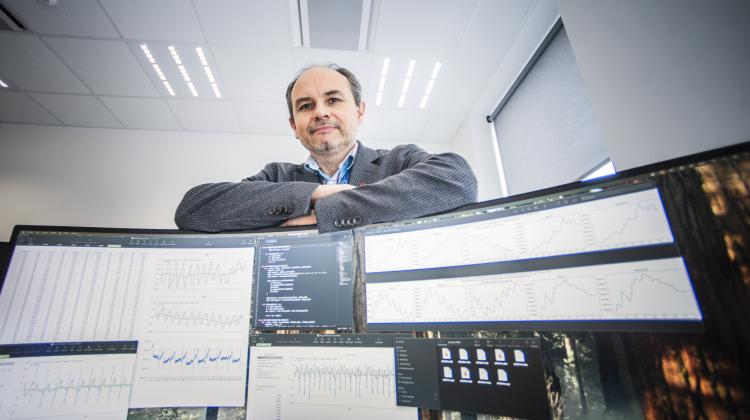The company AKRIMTECH sp. z o.o., established for this purpose, has been working on building prototypes that will be tested by three clinics in Poland. Test results will show whether significant progress in increasing the availability of stem cell therapies, reducing the cost of , and waiting time for such procedures will be possible.
How does it work?
The bioreactor will be an automatically controlled, closed-cycle system for expansion of stem cells in single-use cartridges, which will reduce the time required for expansion to the desired quality of the product by maintaining consistent culture environment parameters (e.g. temperature, pH level, CO2, glucose, and lactic acid concentration).
The advanced bioreactor for research and production will be equipped with single-use, cell mass expansion surfaces manufactured with 3D printing technology, thus eliminating the need for washing and sterilization of vessels as is the case with standard culture methods.
Currently, stem cells are most often grown in sterile, disposable culture vessels (polystyrene flasks), in which they wait to be dispensed as a medical preparation. The process is time-consuming and material-intensive.
Therefore, the technological challenge of constructing a bioreactor to increase the competitiveness of the process resides in:
-
cutting down the time of stem cell expansion - stem cells start to become unstable after about 14 days, so in order to preserve their optimal properties it is necessary to search for ways to shorten expansion process, thus reducing the labor and material use in production,
-
minimizing the risk of contamination of stem cell preparation so as to retain its quality and avoid damage resulting from contamination,
-
process automation to improve control of culture environment with respect to temperature and atmosphere.
Why this technology is better
The current state-of-the-art technologies of stem cell expansion include incubators and laminin matrices, whose use in the production process runs the aforementioned risks.
The use of the bioreactor will:
-
improve expansion efficiency and microbiological safety,
-
reduce labor and material intensity of culture process, and thus lower its costs compared to the current technology.
Currently, bioreactors are not used to expand stem cells used in the treatment of human diseases, and thanks to the development of this technology, a real breakthrough can be achieved in personalized medicine that seeks to adapt medical decisions, actions, and therapies to individual patients.
Making the most of stem cell therapy
The main advantage of stem cells, and more precisely mesenchymal stem cells (MSC) is their capacity for differentiation into lineages of mesenchymal tissues including bone, cartilage, fat, connective tissue of many organs, and bone marrow stroma for haematopoietic cells. This makes MSCs suitable for use in diseases or their stages, for which no other treatment is available today or is ineffective, especially in autoimmune diseases. Examples of such medical conditions include multiple sclerosis, nonspecific inflammatory bowel diseases and, above all, leukaemias and lymphomas - approximately 80 different diseases altogether.
Today, stem cells are used primarily in the treatment of haematopoietic and lymphatic system diseases (e.g. leukaemia, lymphoma). The incidence rate in Poland in 2015 was 17/100 000 ( twofold increase since 1990). The risk of these diseases increases with age - in children it is about 6/100 000. The second area of application of stem cells is regenerative medicine, where patients suffering from various other incurable diseases, mainly neurological: cerebral palsy, autism, multiple sclerosis, or amyotrophic lateral sclerosis, are treated with experimental therapies and in clinical trials.
Cells that are used in all these medical conditions are derived from fetal tissues (umbilical cord, umbilical cord blood, and placenta) and a number of locations in the adult body, of which bone marrow and adipose tissue are of greatest practical importance. It is worth noting that the desired effects can only be achieved with a sufficiently large number of these cells. Cell expansion technologies provide a way to multiply the number of cells. These technologies are in the phase of advanced clinical trials whose early results have been positive, which gives hope that in the coming years it will be possible to use stem cells on a large scale.
In recent years, Stem Cell Banks, where cord blood collected during delivery can be stored for many years, have been growing in popularity. The advantage of cord blood cells lies in their age since they do not have a history of any diseases or mutations, which means that they will always be the youngest cells that can be obtained for therapy. Interestingly, it has been verified in practice that the earliest cells (frozen in the mid 1980s to –190oC), thawed after nearly 24 years, behaved in the way they used to do prior to freezing, which means that they were alive and fit for transplantation.
The average volume of umbilical cord blood is about 75 milliliters. However, it is not the volume that matters most but the number of cells it contains, usually between 800 million and a billion cells per batch. The number of cells is important for transplantation (in haemato-oncology), where the recommended dose is 20-25 million cells per kilogram of body weight. Hence, an average batch of cord blood should only be sufficient for a 40-50 kg recipient. Often, if the patient is an adult, this number of cells will not be enough, and this is when a need for cell expansion arises.
Let's hope that soon advanced and entirely safe stem cell therapies for treating diseases will be available to us as their list is growing year by year.




